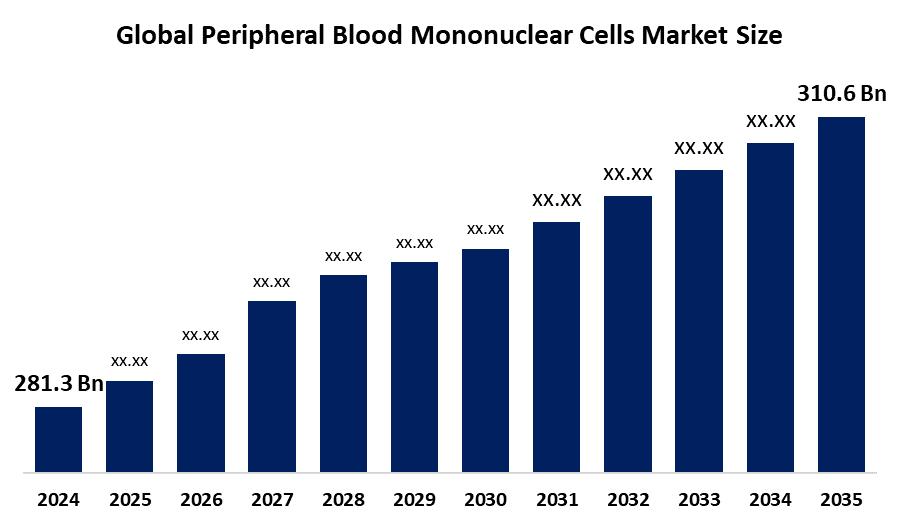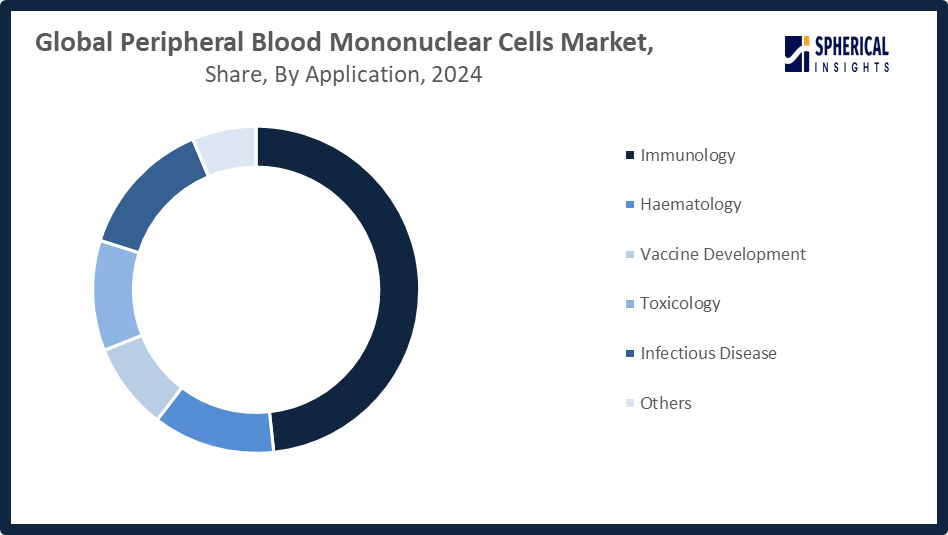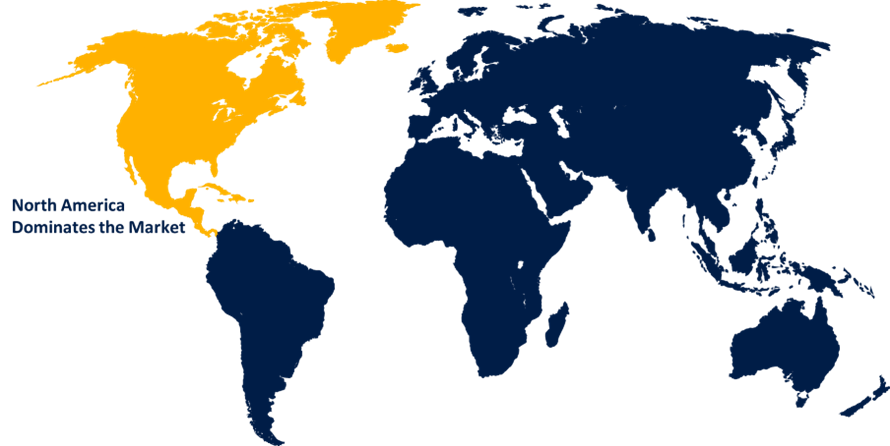Global Peripheral Blood Mononuclear Cells Market Size, Share, and COVID-19 Impact Analysis, By Product (Cryopreserved or Frozen PBMC, Cultured or Fresh PBMC, Peripheral Blood Mononuclear Cell Isolation & Viability Kits, and Others), By Application (Immunology, Haematology, Vaccine Development, Toxicology, Infectious Disease, and Others), By Region (North America, Europe, Asia-Pacific, Latin America, Middle East, and Africa), Analysis and Forecast 2025 - 2035
Industry: HealthcareGlobal Peripheral Blood Mononuclear Cells Market Insights Forecasts to 2035
- The Global Peripheral Blood Mononuclear Cells Market Size Was Estimated at USD 281.3 Billion in 2024
- The Market Size is Expected to Grow at a CAGR of around 10.27% from 2025 to 2035
- The Worldwide Peripheral Blood Mononuclear Cells Market Size is Expected to Reach USD 824.57 Billion by 2035
- Asia Pacific is expected to grow the fastest during the forecast period.

Get more details on this report -
According to a research report published by Spherical Insights and Consulting, The Global Peripheral Blood Mononuclear Cells Market Size was worth around USD 281.3 Billion in 2024, growing to USD 310.6 Billion in 2025, and is predicted to grow to around USD 824.57 Billion by 2035 with a compound annual growth rate (CAGR) of 10.27% from 2025 to 2035. The peripheral blood mononuclear cells (PBMC) market is expanding owing to increasing demand for cell-based research, immunotherapy, and personalized medicine. Rising prevalence of chronic diseases, growth of biomedical research, and increasing clinical trials are additionally fueling PBMC application in drug discovery, vaccine production, and immunological research.
Global Peripheral Blood Mononuclear Cells Market Forecast and Revenue Outlook
- 2024 Market Size: USD 281.3 Billion
- 2025 Market Size: USD 310.6 Billion
- 2035 Projected Market Size: USD 824.57 Billion
- CAGR (2025-2035): 10.27%
- North America: Largest market in 2024
- Asia Pacific: Fastest growing market
Market Overview
The peripheral blood mononuclear cells (PBMC) market refers to the procurement, processing, and utilization of one-round nucleus blood cells, such as lymphocytes and monocytes. These cells are of immense importance in both biomedical research and therapeutic applications, particularly in the fields of immunology, infectious diseases, cancer research, and vaccine development. PBMCs find extensive applications in cell-based therapies such as immunotherapy, drug discovery and development, and toxicity testing, owing to their central role in the functioning of the immune system. Market expansion is driven by the growing demand for targeted or personalized medicine, the rising prevalence of chronic and infectious diseases, the increasing adoption of immunotherapies, and ongoing advancements in isolation and storage methods.
There are opportunities in the growth of clinical trials, regenerative medicine, and biopharmaceutical research, especially with the growing emphasis on precision medicine. Market leaders Lonza, Thermo Fisher Scientific, and BioIVT underpin the industry with innovations in cell processing and distribution. Furthermore, encouraging government policies and funding, particularly in the U.S. and Europe, fosters R&D in cellular therapies and disease modeling. In May 2025, the International Society for Cell & Gene Therapy (ISCT) published updated guidelines for the management of human cellular materials, such as PBMCs, based on standardized collection, processing, and storage procedures to advance uniformity and reliability for clinical research uses.
Key Market Insights
- North America is expected to account for the largest share in the peripheral blood mononuclear cells market during the forecast period.
- In terms of product, the cryopreserved or frozen PBMC segment is projected to lead the peripheral blood mononuclear cells market throughout the forecast period
- In terms of application, the immunology segment captured the largest portion of the market
Peripheral Blood Mononuclear Cells Market Trends
- Rising demand for immunotherapy is boosting PBMC applications.
- Advancements in cell isolation technologies enhance efficiency.
- Increasing focus on personalized medicine drives market growth.
- Expansion of clinical trials fuels market needs.
- Growing use in vaccine development supports demand.
Report Coverage
This research report categorizes the peripheral blood mononuclear cells market based on various segments and regions, forecasts revenue growth, and analyzes trends in each submarket. The report analyzes the key growth drivers, opportunities, and challenges influencing the peripheral blood mononuclear cells market. Recent market developments and competitive strategies, such as expansion, type launch, development, partnership, merger, and acquisition, have been included to draw the competitive landscape in the market. The report strategically identifies and profiles the key market players and analyzes their core competencies in each sub-segment of the peripheral blood mononuclear cells market.
Global Peripheral Blood Mononuclear Cells Market Report Coverage
| Report Coverage | Details |
|---|---|
| Base Year: | 2024 |
| Market Size in 2024: | USD 281.3 Billion |
| Forecast Period: | 2025-2035 |
| Forecast Period CAGR 2025-2035 : | 10.27% |
| 2035 Value Projection: | USD 824.57 Billion |
| Historical Data for: | 2020-2023 |
| No. of Pages: | 245 |
| Tables, Charts & Figures: | 121 |
| Segments covered: | By Product, By Application, By Region |
| Companies covered:: | Lonza Group AG, Bio-Rad Laboratories, Thermo Fisher Scientific, BioIVT LLC, STEMCELL Technologies, Ray Biotech Life, Inc., iXCells Biotechnologies, ZEN-Bio Inc., Corning Incorporated, Charles River Laboratories, Precision Medicine Group, LLC., Biopredic International Corning Inc., Others, and |
| Pitfalls & Challenges: | Covid 19 Impact Challenges, Future, Growth and Analysis |
Get more details on this report -
Driving factors
Demand for cell-based therapies such as immunotherapy, increasing R&D, and improved isolation techniques are major drivers of the peripheral blood mononuclear cells market. The increasing demand for cell-based treatments, especially immunotherapy, is one major driver of the PBMC market since these cells are crucial for immune response modulation. Increasing research and development activities further augment market growth through new applications and better therapeutic effectiveness. Moreover, improvements in PBMC isolation methodologies improve cell purity and viability, which makes them amenable to clinical and research applications.
Restraining Factor
The main restraining factors for the market for peripheral blood mononuclear cells are lower funding and high processing variability. Lower funding restricts spending on PBMC research, clinical trials, and infrastructure, retarding innovation and growth in the market. High processing variability induces variable cell quality, impacting reproducibility and reliability in applications, thus inhibiting wider clinical and commercial usage.
Market Segmentation
The global peripheral blood mononuclear cells market is divided into product and application.
Global Peripheral Blood Mononuclear Cells Market, By Product:
Why did the cryopreserved or frozen PBMC segment dominate the market in 2024?
cryopreserved or frozen PBMC segment dominated, accounting for approximately 46.53% of the market share. This is due to their viability and functionality, offering researchers convenient, flexible options for future use in immunology and cell assays. Companies focus on enhancing freezing and thawing methods to ensure sample readiness after storage while meeting regulations. Increased demand from drug discovery, antibody development, and autoimmune disease research drives this segment’s growth.
The cultured or fresh PBMC segment in the peripheral blood mononuclear cells market is expected to grow at the fastest CAGR over the forecast period. This segment represented approximately 15.5% of the market share. Growth is driven by the rise in animal-free testing, recognition of PBMCs in CAR-T therapies, disease research, and drug discovery. Increased immune response studies, quality management in PBMC processing, and uses in vaccines and reproductive therapies also boost market expansion.
Global Peripheral Blood Mononuclear Cells Market, By Application:
What factors contributed to the dominance of the immunology segment in the market?
The immunology segment led the PBMC market, with an approximate 48% market share. This is due to widespread use in studying immune cell functions, disease progression, and long-term immunity through innate and adaptive responses. PBMCs are essential for liquid biopsies, immunophenotyping, immune monitoring, and bioinformatics. They also play key roles in cancer immunology, immunotherapy prediction, organoid co-culture, genome editing, and metabolic reprogramming during immune responses.

Get more details on this report -
The infectious disease segment in the peripheral blood mononuclear cells market is expected to grow at the fastest CAGR over the forecast period. The infectious disease segment is approximately 14% of the market share. PBMCs are extensively used to study infectious diseases such as HIV, influenza, and COVID-19, as well as fungal infections. Market growth is driven by rising infectious disease cases, drug resistance, increased R&D funding, personalized treatment, improved diagnostics, and greater public awareness of early detection and prevention.
Regional Segment Analysis of the Global Peripheral Blood Mononuclear Cells Market
- North America (U.S., Canada, Mexico)
- Europe (Germany, France, U.K., Italy, Spain, Rest of Europe)
- Asia-Pacific (China, Japan, India, Rest of APAC)
- South America (Brazil and the Rest of South America)
- The Middle East and Africa (UAE, South Africa, Rest of MEA)
North America Peripheral Blood Mononuclear Cells Market Trends

Get more details on this report -
Why does North America dominate the global peripheral blood mononuclear cells market?
North America dominated the global peripheral blood mononuclear cells market, with approximately 45% of market share, driven by advancements in cell and gene therapies and high demand for cell-based treatments. The U.S. leads the region with growing research initiatives, increasing contract research organizations, and expanding service capabilities. Support from government bodies like the NIH and FDA funding and regulation further boost market growth. Rising chronic and age-related disorders also contribute to the expanding peripheral blood mononuclear cells market.
What are the key trends in the U.S. peripheral blood mononuclear cells market?
Key trends in the U.S. peripheral blood mononuclear cells market include rising demand for cell therapies, increased research and toxicology testing, expansion of contract research organizations, and strong government support through funding and regulation, driving market growth and innovation.
Asia Pacific Peripheral Blood Mononuclear Cells Market Trends
Why is the peripheral blood mononuclear cells market expanding rapidly in the Asia Pacific during the forecast period?
The peripheral blood mononuclear cells market is expanding rapidly in the Asia Pacific, with approximately 21% of market share, due to increasing investments in healthcare infrastructure and growing awareness of advanced cell-based therapies. The rising prevalence of chronic diseases and aging populations drives demand for innovative treatments. Additionally, supportive government initiatives and supportive regulatory policies encourage research and development activities. The region also benefits from a large patient pool and expanding contract research organizations, facilitating clinical trials and product development. Growing collaborations between local and international biotech firms further accelerate market growth, making the Asia Pacific the fastest-growing market for peripheral blood mononuclear cells during the forecast period.
Why are specific trends emerging in the Indian peripheral blood mononuclear cells market?
Specific trends in India’s peripheral blood mononuclear cells market are emerging due to increasing healthcare investments, growing awareness of cell-based therapies, rising chronic disease cases, expanding research initiatives, and supportive government policies promoting biotechnology and clinical trials for advanced treatment development.
Why is the peripheral blood mononuclear cells market growing in China?
The peripheral blood mononuclear cells market in China is growing due to increased healthcare investments, rising chronic diseases, government support for biotech research, expanding clinical trials, and growing adoption of advanced cell-based therapies across the country.
Why are specific trends emerging in the Japan peripheral blood mononuclear cells market?
Specific trends in Japan’s peripheral blood mononuclear cells market are emerging due to advanced healthcare infrastructure, aging population, increased government funding for regenerative medicine, growing research activities, and rising demand for innovative cell-based therapies in disease treatment.
Europe Peripheral Blood Mononuclear Cells Market Trends
What are the key growth trends in the European peripheral blood mononuclear cells market?
Key growth trends in Europe’s peripheral blood mononuclear cells market, with approximately 24% of market share, include increased adoption of advanced cell-based therapies, significant investments in biotechnology research, and growing collaborations between academic institutions and industry. Additionally, supportive regulatory frameworks and the rising prevalence of chronic diseases drive demand. Expansion of contract research organizations and increasing clinical trials also contribute to the market’s steady growth across the region.
The EU’s EU4Health program, with a €5.1 billion budget (2021-2027), promotes access to biological materials, data sharing, and standardized sample preparation across member states, enabling wider use of PBMCs in public health research and innovation.
Why is the peripheral blood mononuclear cells market evolving in Germany?
The peripheral blood mononuclear cells market in Germany is evolving due to strong government support for biotech innovation, advanced healthcare infrastructure, increasing research and clinical trials, rising demand for cell therapies, and growing investments in regenerative medicine and personalized treatment approaches.
Competitive Analysis:
The report offers the appropriate analysis of the key organizations/companies involved within the global peripheral blood mononuclear cells market, along with a comparative evaluation primarily based on their type of offering, business overviews, geographic presence, enterprise strategies, segment market share, and SWOT analysis. The report also provides an elaborate analysis focusing on the current news and developments of the companies, which includes type development, innovations, joint ventures, partnerships, mergers & acquisitions, strategic alliances, and others. This allows for the evaluation of the overall competition within the market.
Worldwide Top Key Players In The Peripheral Blood Mononuclear Cells Market Include
- Lonza Group AG
- Bio-Rad Laboratories
- Thermo Fisher Scientific
- BioIVT LLC
- STEMCELL Technologies
- Ray Biotech Life, Inc.
- iXCells Biotechnologies
- ZEN-Bio Inc.
- Corning Incorporated
- Charles River Laboratories
- Precision Medicine Group, LLC.
- Biopredic International Corning Inc.
- Others
Key Target Audience
- Market Players
- Investors
- End-users
- Government Authorities
- Consulting And Research Firm
- Venture capitalists
- Value-Added Resellers (VARs)
Recent development
- In April 2025, Charles River Laboratories announced updates to its oncology drug discovery portfolio ahead of AACR. Cancer cases are projected to reach 35 million by 2050, with 1 in 5 people developing cancer in their lifetime.
- In November 2024, BioIVT LLC expanded its human biospecimen collection, increasing capacity to provide high-quality cryopreserved PBMCs for enhanced drug discovery and development support.
- In August 2024, Charles River Laboratories acquired a specialized cell therapy CRO, boosting its human PBMC services for preclinical and clinical research and expanding its cell and gene therapy capabilities.
- In July 2024, Scinai Immunotherapeutic announced promising pre-clinical results for its anti-IL-17A/F VHH antibody fragment (NanoAb), a novel intralesional treatment for mild to moderate plaque psoriasis, using human peripheral blood mononuclear cells to induce psoriasis in the study.
- In June 2024, Bio-Rad Laboratories launched Celselect Slides 2.0, enhancing rare cell and circulating tumor cell capture. Compatible with the Genesis Cell Isolation System, it processes larger liquid biopsy volumes and improves CTC capture for enumeration and downstream applications.
- In July 2023, Thermo Fisher Scientific launched an automated system for high-throughput PBMC isolation, enhancing laboratory efficiency, consistency, and cell yield for diverse research applications.
Market Segment
This study forecasts revenue at the global, regional, and country levels from 2020 to 2035. Spherical Insights has segmented the peripheral blood mononuclear cells market based on the following segments:
Global Peripheral Blood Mononuclear Cells Market, By Product
- Cryopreserved or Frozen PBMC
- Cultured or Fresh PBMC
- Peripheral Blood Mononuclear Cell Isolation & Viability Kits
- Others
Global Peripheral Blood Mononuclear Cells Market, By Application
- Immunology
- Haematology
- Vaccine Development
- Toxicology
- Infectious Disease
- Others
Global Peripheral Blood Mononuclear Cells Market, By Regional Analysis
- North America
- US
- Canada
- Mexico
- Europe
- Germany
- UK
- France
- Italy
- Spain
- Russia
- Rest of Europe
- Asia Pacific
- China
- Japan
- India
- South Korea
- Australia
- Rest of Asia Pacific
- South America
- Brazil
- Argentina
- Rest of South America
- Middle East & Africa
- UAE
- Saudi Arabia
- Qatar
- South Africa
- Rest of the Middle East & Africa
Frequently Asked Questions (FAQ)
-
1. What is the CAGR of the peripheral blood mononuclear cells market over the forecast period?The global peripheral blood mononuclear cells market is projected to expand at a CAGR of 10.27% during the forecast period.
-
2. What is the peripheral blood mononuclear cells market?The peripheral blood mononuclear cells (PBMC) market is a rapidly growing sector focused on the supply and use of PBMCs, which are crucial for biomedical research, drug development, and advanced cell-based therapies like cancer immunotherapies.
-
3. What is the market size of the peripheral blood mononuclear cells market?The global peripheral blood mononuclear cells market size is expected to grow from USD 281.3 billion in 2024 to USD 824.57 billion by 2035, at a CAGR 10.27% of during the forecast period 2025-2035.
-
4. What factors are driving the growth of the peripheral blood mononuclear cells market?Growth in the peripheral blood mononuclear cells (PBMC) market is driven by increased use in cell therapies, regenerative medicine, and immunology research, particularly for treating cancer and autoimmune diseases
-
5. What are the main challenges restricting the wider adoption of the peripheral blood mononuclear cells market?The main challenges restricting the wider adoption of the peripheral blood mononuclear cells (PBMC) market include significant technical complexities, regulatory hurdles, donor and sample variability, high costs, and logistical issues related to handling and transportation.
-
6. Which region holds the largest share of the peripheral blood mononuclear cells market?North America is anticipated to hold the largest share of the peripheral blood mononuclear cells market over the predicted timeframe.
-
7. What are the market trends in the peripheral blood mononuclear cells market?Key market trends include rising demand for cell therapies, increased research, technological advancements, government support, and growing clinical trials globally.
-
8. Who are the top 10 companies operating in the global peripheral blood mononuclear cells market?The major players operating in the peripheral blood mononuclear cells market are Lonza Group AG, Bio-Rad Laboratories, Thermo Fisher Scientific, BioIVT LLC, STEMCELL Technologies, Ray Biotech Life, Inc., iXCells Biotechnologies, ZEN-Bio Inc., Corning Incorporated, Charles River Laboratories, Precision Medicine Group, LLC., Biopredic International Corning Inc., and Others.
Need help to buy this report?